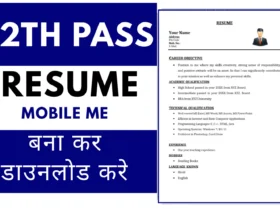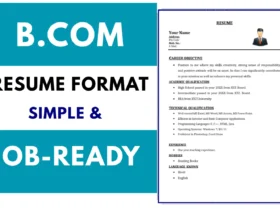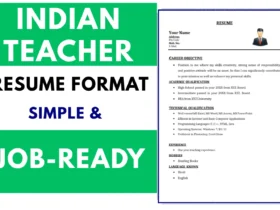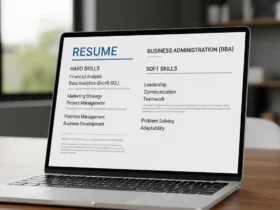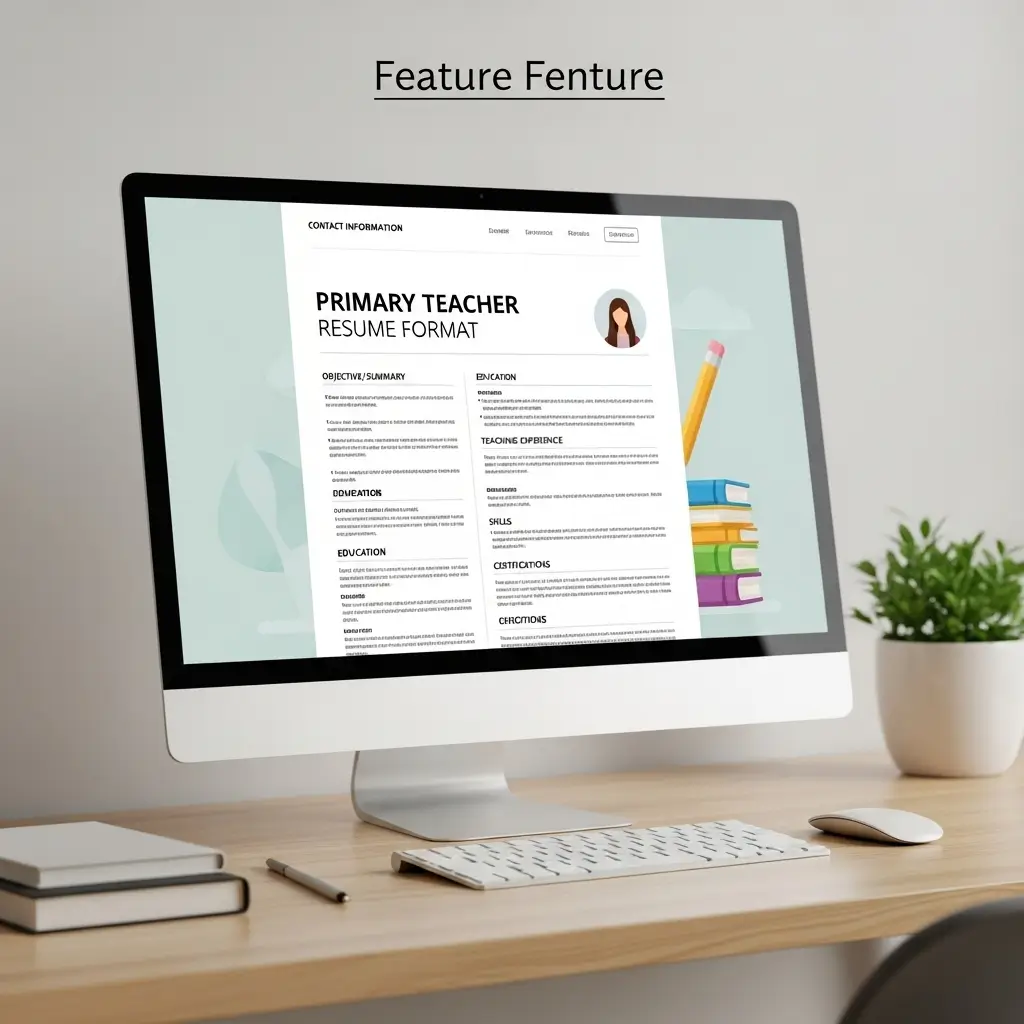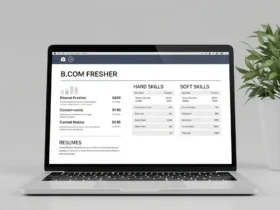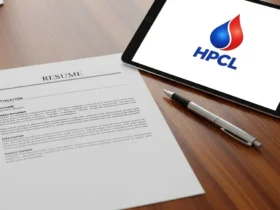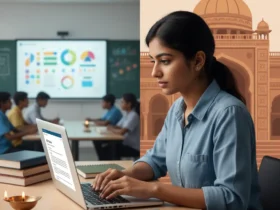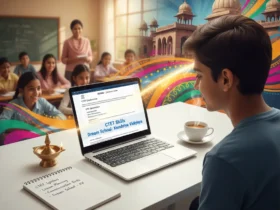Imagine guiding young minds, watching children learn and grow. Teaching primary school kids in India is a noble path, making a real impact on our nation’s future. It is a calling that shapes tomorrow. To land one of these fulfilling roles, you need a strong calling card: your resume. This document is your chance to show schools who you are and what you offer. It is your introduction, your story, told in a clear and compelling way. We will walk through how to build a clear, impressive resume, keeping in mind what Indian schools look for today, helping you understand how to write a Primary Teacher Resume Format.
What Your Resume Does
Think of your resume as a short story about your talents, your schooling, and your work life. It is your first way to connect with a potential school. It speaks for you before you even walk through the door. A well-made resume helps you get noticed. Many schools now use computer systems to scan applications, called Applicant Tracking Systems (ATS), so being clear and tidy is super important. These systems look for specific words and formats. If your resume is not set up right, it might not even reach a human eye.
We will cover the main bits: your contact details, a brief opening statement, your past work, your degrees, and your talents. Each part plays a big role in showing you are a good fit for teaching kids in India, giving them a strong Primary Teacher Resume Format.
Sample Primary Teacher Resume Format (Easy to Copy)
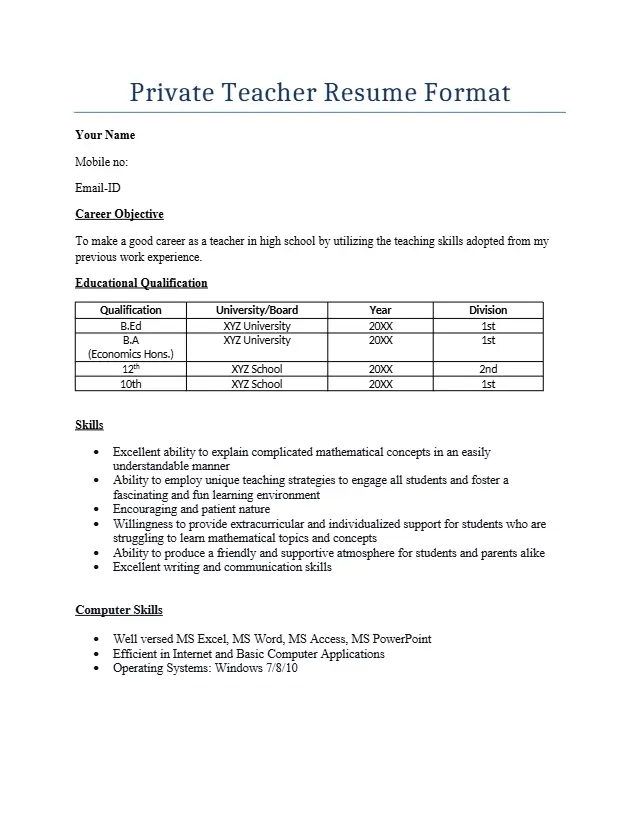
👉 Download Link: [Get Here]
You can:
- Fill it in Adobe or any PDF app
- Print it on clean A4 paper
How Teacher Applications Have Changed in India
Teaching has a long and valued history in our country. Long ago, in places like Gurukuls, teachers (Gurus) were chosen for their deep knowledge and good character, not by a paper document. It was all about reputation and a personal bond. There were no official “how to write Primary Teacher Resume Format” guides back then!
When the British came, things got a bit more formal. People started filling out “biodata” forms. These documents listed schooling and basic training certificates, like the old L.T. (Licentiate in Teaching) or B.T. (Bachelor in Teaching). Sometimes, family background details were also included.
After 1947, India focused on growing its education system. Degrees like the B.Ed. became more common. Application forms became more structured, moving closer to what we see today, with less focus on personal details and more on professional history. Teacher Eligibility Tests (TETs) also became a key part of securing a teaching spot in many government schools. This move marked a big change in primary teacher qualifications India looked for.
Today’s modern Indian resumes mix global styles with some local touches, like sometimes including marital status or nationality, which are unique to our context. This shows how our application methods have grown and changed over time, much like our nation itself.
What Schools Look For Today
Schools are now looking past just grades. They want teachers who can make learning fun and meaningful. They want people who bring life and joy to the classroom.
India’s New Education Policy (NEP 2020) wants teachers to encourage active learning, thinking for oneself, and creativity. When writing your resume, show examples of how you would help kids understand concepts, not just memorize them. Did you lead a project where students built a model of a famous Indian monument? Mention it! This policy has a big NEP 2020 impact on teacher resumes India schools see.
Being good with technology is a big plus. Can you use online tools for lessons? Are you comfy with smart boards or learning apps like DIKSHA, which many Indian schools now use? Show your ability to blend tech with teaching. This highlights digital skills for primary teacher resume applications look for.
“Soft” talents like good speaking skills, patience, and working well with other teachers and parents are highly valued. Show how you connect with children from different backgrounds across our diverse country, maybe through stories or local games. Schools want teachers who create a warm, supportive room where every child feels seen and heard, a place where every child, from a big city to a small village, feels at home. These are the kinds of talents for primary teacher resume India needs.
Navigating the Tricky Bits: Common Hurdles
Crafting a good Primary Teacher Resume can sometimes feel like solving a puzzle, especially with the many rules in India. One common puzzle is about degrees. There is often confusion about which degree is right for primary teaching. Should it be a D.El.Ed., B.El.Ed., or B.Ed.? Recent court rulings have added to this discussion, making it tricky for teachers to know what to put first. This directly relates to primary teacher qualifications India recruiters want to see.
Then there are state-by-state rules. Each Indian state has its own set of rules and requirements for teachers, including different Teacher Eligibility Tests. Moving from, say, Uttar Pradesh to Tamil Nadu, means checking new guidelines. Your resume needs to adjust for these local needs, including local language knowledge. For example, knowing Tamil can be a big plus in Chennai, just as knowing Marathi is in Mumbai.
Primary teachers often handle many subjects and activities – from teaching math to leading a school play, or even organizing a small annual function. How do you fit all that diverse work onto a short resume? It is about picking the best examples and showing how they made a difference in the children’s learning journey or school life.
India’s classrooms are rich with many cultures and languages. Teachers face the challenge of making sure every child feels included and learns well, whether they come from Kerala or Kashmir. Your resume can show how you have worked with kids from different communities, perhaps by using folk tales from various regions in your lessons.
Lastly, there is the history of “para-teachers.” In some areas, schools have used “para-teachers” on short contracts, sometimes without the same formal degrees. This history affects how qualifications are viewed and valued, adding another layer to the teaching landscape.
What the Future Holds for Teachers
The world of teaching is always changing, and India is no exception. Here is what you can look forward to, and how your resume can shine in the years to come.
Get ready for more tech in classrooms. Look forward to things like Artificial Intelligence (AI) helping teach and personalized learning, where lessons are tweaked just for one child. Your resume should show you are open to using these new tools and learning about them. Maybe you tried a simple coding game with students? Mention it! This really shows your digital skills for primary teacher resume India.
NEP 2020’s big plan says that by 2030, a four-year integrated B.Ed. degree might become the main requirement for all teachers. If you are pursuing this or plan to, it is a big advantage to highlight. It shows you are forward-thinking and ready for the future. This is a big NEP 2020 impact on teacher resumes India.
Beyond your paper resume, schools will look at your online story. A professional LinkedIn profile or a digital collection of your teaching work (a portfolio with pictures of student projects or videos of you teaching) can make you stand out. This gives a fuller picture of your talents.
Schools want young teachers (around 30-35 years old) who bring new ideas and are ready to try new ways of teaching. Show your willingness to adapt and grow. Maybe you volunteered for a new school program or tried a fun, fresh teaching method.
Making a difference in villages is also a big part of India’s future. Our nation still needs many good teachers in its rural parts. If you are ready to work in these areas, show it. There may be special programs or support for you.
The New Education Policy aims for clear and fair ways to pick teachers, with promotions based on good work. This means your resume’s content will matter even more, making it a true reflection of your abilities and dedication. Your primary teacher job application tips India will soon include knowing these future trends.
Concluding Thoughts
Your resume is more than just a document; it is your chance to show your passion for teaching and your commitment to shaping young lives in India. It is your personal advertisement, telling schools why you are the best person to guide their young learners.
To make it truly shine, keep it tidy, clear, and specific. Tailor it for each school, showing how your skills match what they seek. Make sure to talk about your digital skills and how you bring NEP 2020 ideas to life. Think of your resume as a showcase of your best teaching moments and future potential. This is how to write primary teacher resume India that gets noticed.
You have the power to light up young minds. With a strong Primary Teacher Resume, you are ready to start that journey and become a beloved primary school teacher in our nation. Go forth and inspire!
Common Questions About Your Primary Teacher Resume
What should I put in my resume if I am new to teaching primary school?
Tell about your teaching goals, any student teaching or school practice you have done, your degrees, and any talents related to working with kids. Mention any good scores or honors from your schooling. This is key for a resume format for school teacher fresher India.
How many pages should my primary teacher resume be?
Aim for one page, especially if you are just starting. If you have many years of work that truly adds value, then two pages are fine.
What kinds of talents should I list on my resume?
List things like managing a room, planning lessons, using teaching apps, understanding how kids grow, and being patient. Also, include communicating with parents, working with other teachers, and being good at solving problems. These are top skills for primary teacher resume India looks for.
Is a short opening paragraph (summary or objective) really needed?
Yes! A brief 3-4 sentence paragraph at the top helps schools quickly grasp who you are, what you hope to do, and your main talents. For new teachers, this is a spot to show your passion. This is what to include in teacher resume India at the very start.
How important is a letter with my resume?
Always send a letter! It lets you share why you truly want that particular job and how your teaching style fits the school’s vision. It adds a personal touch. This is a top primary teacher job application tips India.
Should I include hobbies or activities outside of school?
Yes, if they show good qualities for teaching! For example, leading a local youth group or volunteering at a children’s event can show you are well-rounded and care about kids.
What is an ATS-friendly resume, and why does it matter?
ATS stands for Applicant Tracking System. Many schools use computer programs to sort resumes. An “ATS-friendly” resume uses clear fonts, simple design, and has words that match the job description, so the computer can read it easily.
Which degrees are generally best for teaching primary school in India?
For primary roles, degrees like a Diploma in Elementary Education (D.El.Ed. or D.Ed.) or a Bachelor of Elementary Education (B.El.Ed.) are often preferred. A B.Ed. is also common, but recent discussions suggest other diplomas may be seen as more direct for young children. Clearing the CTET or your state’s TET is also a must for many places. This covers primary teacher qualifications India requires.
Do I need to know a local language to teach primary school in India?
Often, yes. Being fluent in English and the local language of the region you want to teach in is a big plus. It helps you connect with both the children and their parents.

